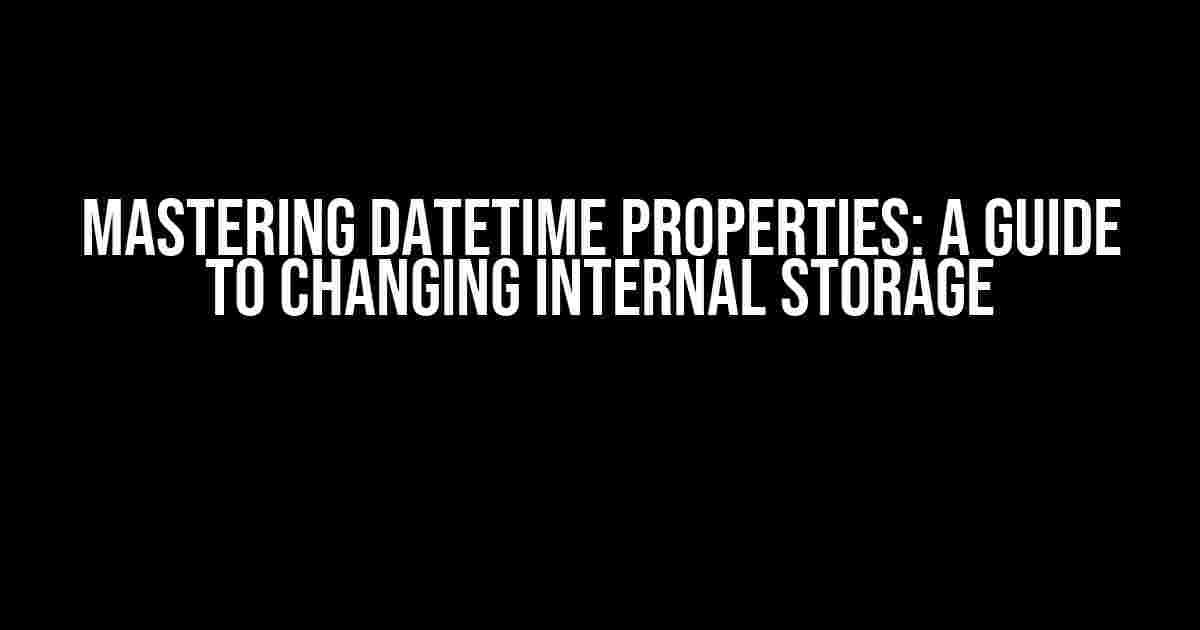Introduction
When working with dates and times in programming, the DateTime property is an essential component. It allows developers to store and manipulate temporal data with ease. However, have you ever encountered a situation where you need to change the internal storage of a DateTime property? Perhaps you want to switch from one format to another or adjust the precision of your timestamps. In this article, we’ll dive into the world of DateTime properties and explore the various ways to modify their internal storage.
Understanding DateTime Properties
Before we delve into the nitty-gritty of changing internal storage, it’s essential to understand the fundamentals of DateTime properties. A DateTime property is a data type that represents a specific point in time, including the date, hour, minute, second, and fraction of a second. It’s a complex data type that consists of multiple components, each with its own set of rules and limitations.
Components of a DateTime Property
A typical DateTime property comprises the following components:
Date: The date component represents the year, month, and day of the month.Time: The time component represents the hour, minute, second, and fraction of a second.Time Zone: The time zone component represents the offset from Coordinated Universal Time (UTC).
Why Change Internal Storage of a DateTime Property?
There are several scenarios where modifying the internal storage of a DateTime property becomes necessary:
- Format Conversion: You may need to change the format of your DateTime property from one format to another, such as from UTC to a specific time zone or from a 12-hour clock to a 24-hour clock.
- Precision Adjustment: You may want to adjust the precision of your timestamps, such as changing from millisecond precision to microsecond precision.
- Data Migration: When migrating data from one system to another, you may need to adapt the internal storage of DateTime properties to match the new system’s requirements.
- Performance Optimization: Modifying the internal storage of DateTime properties can help optimize performance in certain scenarios, such as when working with large datasets.
Methods for Changing Internal Storage of a DateTime Property
Now that we’ve established the importance of modifying the internal storage of DateTime properties, let’s explore the various methods for doing so:
Method 1: Using the ToUniversalTime() Method
The ToUniversalTime() method converts a DateTime property from a local time zone to UTC. This method is useful when you need to standardize your timestamps across different time zones.
DateTime localDateTime = DateTime.Now;
DateTime universalDateTime = localDateTime.ToUniversalTime();
Method 2: Using the SpecifyKind() Method
The SpecifyKind() method sets the time zone kind of a DateTime property. You can use this method to change the time zone kind from local to UTC or vice versa.
DateTime localDateTime = DateTime.Now;
DateTime universalDateTime = DateTime.SpecifyKind(localDateTime, DateTimeKind.Utc);
Method 3: Using the ToString() Method with Format Specifiers
The ToString() method with format specifiers allows you to convert a DateTime property to a string in a specific format. This method is useful when you need to change the format of your timestamps.
DateTime dateTime = DateTime.Now;
string formattedDateTime = dateTime.ToString("yyyy-MM-dd HH:mm:ss.fff");
Method 4: Using the Ticks Property
The Ticks property represents the number of ticks (100-nanosecond intervals) in a DateTime property. You can use this property to adjust the precision of your timestamps.
DateTime dateTime = DateTime.Now;
long ticks = dateTime.Ticks;
// Adjust the precision of the timestamp
ticks += 1000; // Add 1 millisecond
DateTime adjustedDateTime = new DateTime(ticks);
Best Practices for Changing Internal Storage of a DateTime Property
When modifying the internal storage of a DateTime property, it’s essential to follow best practices to avoid common pitfalls:
| Best Practice | Description |
|---|---|
| Use Standard Formats | Use standard formats for your timestamps, such as ISO 8601, to ensure consistency and interoperability. |
| Avoid Ambiguous Formats | Avoid using ambiguous formats, such as “MM/dd/yyyy”, which can be interpreted differently in different cultures. |
| Consider Time Zone Implications | When changing the internal storage of a DateTime property, consider the implications of time zones and daylight saving time. |
| Test Thoroughly | Test your code thoroughly to ensure that the modified DateTime property behaves as expected in different scenarios. |
Conclusion
In conclusion, changing the internal storage of a DateTime property is a critical task that requires a deep understanding of the underlying components and implications. By following the methods and best practices outlined in this article, you’ll be able to modify the internal storage of DateTime properties with confidence and precision. Remember to always test your code thoroughly and consider the implications of time zones and daylight saving time. With practice and patience, you’ll become a master of DateTime properties.
Do you have any questions or experiences related to changing the internal storage of DateTime properties? Share your thoughts in the comments below!
Frequently Asked Question
Get ready to dive into the world of DateTime properties and explore the intricacies of changing internal storage!
Can I change the internal storage of a DateTime property in C#?
Yes, you can! In C#, the internal storage of a DateTime property is a 64-bit integer value that represents the number of ticks (100-nanosecond intervals) since midnight, January 1, 0001. You can modify this value by using the DateTime.AddTicks method or by assigning a new value to the property.
How do I change the time zone of a DateTime property?
You can change the time zone of a DateTime property by using the DateTime.SpecifyKind method or by converting the DateTime value to a different time zone using the TimeZoneInfo.ConvertTime method. However, keep in mind that the internal storage of the DateTime property remains the same, and only the way it is displayed or calculated changes.
Can I store a DateTime property as a string in the database?
While it’s technically possible to store a DateTime property as a string in a database, it’s not recommended. Storing dates and times as strings can lead to inconsistencies and errors when working with different cultures, time zones, and formats. Instead, use a datetime or timestamp data type in your database to ensure accurate and consistent storage.
How do I serialize a DateTime property when working with JSON?
When serializing a DateTime property to JSON, it’s essential to use a consistent date and time format to avoid errors and inconsistencies. You can use the ISO 8601 format (YYYY-MM-DDTHH:MM:SS.fffffffK) or a custom format that suits your needs. Make sure to specify the DateTimeKind when deserializing the JSON data back to a DateTime property.
Can I use a custom internal storage format for a DateTime property?
No, you cannot use a custom internal storage format for a DateTime property in C#. The internal storage format is determined by the .NET Framework and is not customizable. However, you can create a custom class that wraps a DateTime property and provides a custom storage format, if needed.


